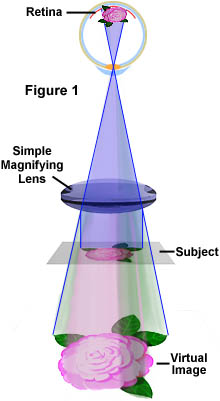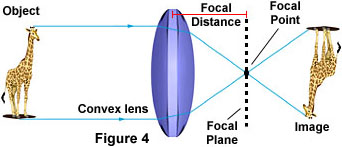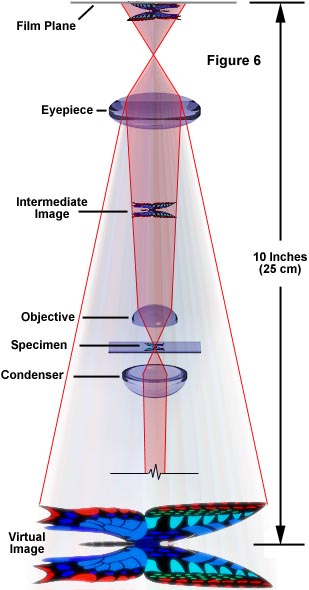

The object is now situated between one and two focal lengths in front of the lens (shown in Figure 5). Now the image is still further away from the back of the lens. This time, the image is magnified and is larger than the object; it is still inverted and it is real. This case describes the functioning of all finite tube length objectives used in microscopy. Such finite tube length objectives project a real, inverted, and magnified image into the body tube of the microscope. This image comes into focus at the plane of the fixed diaphragm in the eyepiece. The distance from the back focal plane of the objective (not necessarily its back lens) to the plane of the fixed diaphragm of the eyepiece is known as the optical tube length of the objective.
¡@
¡@
Now we will describe how a microscope works in somewhat
more detail. The first lens
of a microscope is the one closest to the object being
examined and, for this reason, is
called the objective. Light from either an external or
internal (within the microscope
body) source is first passed through the substage condenser,
which forms a well-defined light cone that is concentrated onto the object
(specimen). Light passes through the specimen and into the objective (similar
to the projection lens of the projector described above), which then projects
a real, inverted, and magnified image of the specimen to a fixed plane
within the microscope that is termed the intermediate image plane (illustrated
in Figure 6). The objective has several major functions:
#The objective must gather the light coming from each of the various parts or points of the specimen.
#The objective must have the capacity to reconstitute the light coming from thevarious points of the specimen into the various corresponding points in the image (Sometimes called anti-points).
#The objective must be constructed so that it will be focused close enough to the specimen so that it will project a magnified, real image up into the body tube.
The intermediate image plane is usually located about 10 millimeters below the top of the microscope body tube at a specific location within the fixed internal diaphragm of the eyepiece. The distance between the back focal plane of the objective and the intermediate image is termed the optical tube length. Note that this value is different from the mechanical tube length of a microscope, which is the distance between the nosepiece (where the objective is mounted) to the top edge of the observation tubes where the eyepieces (oculars) are inserted.
